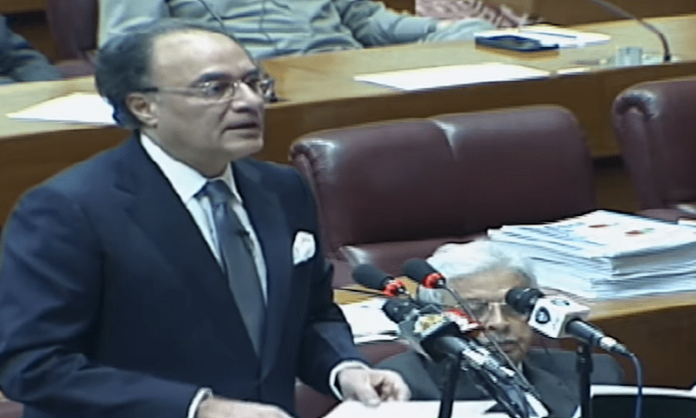By M. Ashraf Wani/Najam-ul-Hassan
ISLAMABAD, Jun 10 (APP)::Building on recent macroeconomic stabilization and a commitment to easing public hardship, the coalition federal government on Tuesday presented its second growth-driven and relief-oriented federal budget for the fiscal year 2025-26, with a total outlay of Rs. 17.573 trillion.
Federal Minister for Finance and Revenue, Senator Muhammad Aurangzeb presented the budget before national assembly.
The budget outlines a comprehensive fiscal plan for building competitive economy focusing to enhance exports, improve foreign exchange reserves, reduce fiscal imbalances and encourage economic productivity.
Minister Aurangzeb stated that the budget was being presented at a pivotal and historic moment, as the nation had exhibited unprecedented unity, courage, and resolve in the face of Indian aggression. “Leveraging this national resolve and unity, the government is now focusing on achieving economic stability, progress, and prosperity,” he remarked.
Relief For Salaried Class
Announcing relief measures, the minister announced a raise of 10 percent in salaries of employees from Grade 1-22 and an increase of 7 percent in the pension of retired employees. The minister also announced 30 percent disparity reduction allowances for eligible employees. He also proposed special relief allowances for military officers and soldiers/JCOs.
Growth Rate
The minister announced a projected economic growth rate of 4.2% for the fiscal year 2025–26. He stated that inflation is expected to remain at 7.5%, while the fiscal deficit has been estimated at 3.9% of GDP. Meanwhile, the primary surplus is projected to reach 2.4% of GDP.
Revenues and Expenditures
He said, the revenues collected target by Federal Board of Revenue (FBR) has been set at Rs.14,131 billion, showing an increase of 18.7 percent compared to fiscal year 2024-25. The federal excise duty is calculated at Rs.8,206 billion. The non –tax revenues are project at Rs.5,147 billion.
The minister said, the net income of federal government would be Rs11,072 billion whereas its expenditures have been estimated at Rs17,573 billion, out of which Rs8,207 billion would be spent on mark up payments.
He said, the current expenditures of federal government were Rs.16,286 billion whereas Rs1,000 billion have been earmarked for the Public Sector Development Programme.
Budget Allocations
He said, since defence of the country was top priority of the government and Rs2,550 billion would be provided for it whereas Rs.971 billion were kept for civil administration expenditures; Rs.1,055 billion for pension expenditures and Rs1,186 billion for subsidy on electricity and other sectors. Likewise, Rs.1,928 billion would be provided for BISP grants, and Azad Jammu and Kashmir, Gilgit-Baltistan and newly merged districts of Khyber Pakhtunkhwa.
The finance minister underscored that the government intended to increase the coverage the flagship initiatives of Benazir Income Support Programme under which the number of beneficiary families will be increased to 10 million. The government has increased the allocated amount for this by 21% to Rs 716 billion.
Economic performance in 2024-25
Outlining economic performance of fiscal year 2024-25, the minister said, the primary surplus was recorded at 2.4 percent of GDP whereas the inflation witnessed considerable reduction and was recorded at 4.7 percent. Likewise, the current account is expected to witness $1.5 billion surplus whereas as rupee has strengthen and remittances increased by 31 percent and are expected to reach $38 billion by the end of this fiscal year. He said, the reserves of State Bank of Pakistan also expected to reach $14 billion.
World Acknowledgements
He said, the macroeconomic stabilization programme of the country was acknowledged worldwide as was indicated by reports by various reputed financial institutions, rating agencies as well as national and international surveys.
FBR Reforms
Similarly, the FBR transformation plan was implemented to leverage people, process, and technology, while the government initiated digital transformation and integration to enhance the overall tax collection system. Key initiatives include digital production tracking, e-invoicing, AI-based audit selection, point-of-sale integration, faceless audits, and more. Additionally, the government is investing in human resource development to further strengthen the organization.
Energy Reforms
He said that significant reforms were introduced in the energy sector, including a 31% reduction in electricity tariffs for industry and 50% for 8 million protected consumers. Furthermore, agreements with Independent Power Producers (IPPs) were renegotiated, expected to save the national exchequer approximately Rs3,000 billion.
He further mentioned the reorganization of NTDC and noted that legislation and procedures had been finalized to promote a competitive and free market for the electricity sector. Additionally, he highlighted reforms in the oil and gas sector aimed at attracting investment to tap its vast potential.
He stated that the government is committed to creating a conducive environment to promote exports, encourage business, and attract investment, noting that the Ministry of Commerce has already taken several initiatives in this direction.
Debt Ratio
He stated that the debt-to-GDP ratio has been reduced from 74% to 70%. Additionally, reforms in State-Owned Enterprises are underway to plug leakages. The government expects to complete the transactions for Pakistan International Airlines (PIA) and the Roosevelt Hotel, and plans to further privatize key assets of DISCOs and GENCOs. Furthermore, rightsizing of various ministries is also in progress.
IT Development
The Minister highlighted IT’s importance for exports, aiming for $25 billion in IT exports within 5 years, while also prioritizing Small and Medium Enterprises development and promoting investment through the Special Investment Facilitation Council.
Agriculture Sector
Emphasizing agriculture as the backbone of the country’s economy, Aurangzeb stated that the government has allocated Rs2,066 billion for agricultural credit and launched several initiatives to provide high-quality seeds. He also underscored the importance of building water reservoirs on a war footing to address challenges and ensure food security.
Taxation Measures
The minister announced major tax relief measures for salaried persons, construction sector, and purchase of immovable property besides introducing tax credit to provide loans to construct low-cost houses.
He said, under the direction of Prime Minister Shehbaz Sharif, the tax burden on the salaried class is being reduced in the upcoming fiscal year. In this regard, he said a significant reduction in income tax rates is proposed for salaried people in all income slabs.
This relief will not only simplify the tax structure but will also ensure a balance between inflation and take-home salary by reducing the tax burden on the middle-income earners.
The tax rate for those earning between Rs. 600,000 and Rs. 1.2 million has been reduced from 5% to just 1%. Furthermore, it is also proposed to reduce the tax amount for salaried people earning between Rs. 1.2 million and Rs 2.2 million from Rs. 30,000 to Rs. 6,000 and the minimum tax rate is also proposed to be reduced to 11% from 15%.
Similarly, a reduction in tax rate is being proposed for those earning higher salaries. The tax rate for those earning between Rs. 2.2 million and Rs. 3.2 million is proposed to be reduced from 25% to 23%. This move reflects the government’s commitment to making taxes fairer and reducing the burden on salaried individuals, the finance minister said.
In order to stop brain drain from the country, he said that the government has proposed to remove one percent surcharge on the people having income of more than 10 million.
He said the super tax rate on the corporations earning annual income between Rs 200 million to 500 million is being reduced by 0.5%.
In the construction sector, the government has also proposed to reduce the rate of Withholding Tax on the purchase of property from 4% to 2.5%, from 3.5% to 2%, and from 3% to 1.5%.
Likewise, the finance minister also announced to eliminate the federal excise duty of up to 7% imposed last year on the transfer of commercial properties, plots, and houses.
Furthermore, he said tax credit is being introduced for houses up to 10 marla and flats of up to 2000 sqft to provide loans for the construction of low-cost houses and to encourage mortgage.
The government has also proposed to reduce the stamp paper duty on the purchase of property in Islamabad from 4% to 1%. He hoped that the provinces will also support the federal government’s move by slashing heavy taxes imposed on the immovable property.
He said the tax rate on the interest income has been proposed to increase from current 15% to 20%. However, he made it clear that this increase will not apply on the national savings and small scale savings.
The finance minister highlighted that new tax was being introduced for e-commerce platforms, courier services and other digital services.
He said the government has proposed 5% tax on the income of pensioners of up to 70 years, whose annual pension exceeds Rs 10 million. He made it clear that the government has no intention to impose tax on the low and middle income pensioners.
In order to promote cashless economy, the government has proposed to increase the advance tax rate on withdrawing cash for the non-filers from current 0.6% to 1%.
“We are making necessary reforms to remove loopholes, improve equity and make tax laws easier to comply with,” the finance minister said adding that rental income from commercial properties will now be recognized at a standard rate of 4% of the fair market value. This will limit the discretionary powers of the tax authorities.
The finance minister said the government was going to propose steps to improve enforcement, reduce tax theft and promote transparency in the tax system.
He said that in order to encourage local manufacturing of solar panels, the government has proposed to impose 18% sales tax on the import of solar panels.
Similarly, the finance minister said the government has decided to remove the tax exemption for the newly merged districts of KP and Balochistan. He said the exemption will be removed step wise during next five years.
He informed that the government has decided not to impose any further tax on fertilizers and pesticides.
The finance minister said in order to discourage fossil fuel in the country, the government has proposed to impose Rs 2.5 carbon levy on one liter of petrol, high speed diesel and furnace oil which will be increased to Rs 5 per liter from the fiscal year 2026-27. Furthermore, petroleum levy on furnace oil will be imposed as per the government announcement.
He said the government has also decided to refinance the current expensive government debts of power sector through cheap and Sharia compliance bank financing to avoid extra expenditures.
He said the government has also proposed to impose additional levy on the import and purchase of cars with petrol and diesel engines.
He said the FBR’s tax-to-GDP ratio which was only 8.8 percent as on June 30, 2024, has been increased to 10.3% in first nine months of current fiscal year and is expected to further increase to 10.4 percent by the end of June 2025.
Federal non-tax revenues have also increased to 1.2 percent of GDP compared to 0.8 percent last year. “Overall, federal revenues are now 11.6 percent of GDP and if we include the provinces’ 0.7 percent tax-to-GDP ratio, the national tax-to-GDP ratio will be 12.3 percent by the end of the current fiscal year,” he added.
As regards relief measures for the salaried persons, the finance minister announced that the government has proposed 10% increase in the employees (BPS 1-22) of the federal government.
Likewise, he said 7% increase in the pensions of the retired employees has also been proposed.
For handicapped employees, the special conveyance allowance is being increased from Rs 4000 to Rs 6000.
In order to reduce disparities among the employees of various departments, provision of 30% disparity reduction allowance has also been proposed for the eligible employees.
Likewise, special relief allowance has also been proposed for the officers/soldiers and JCOs of the armed forces.

